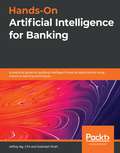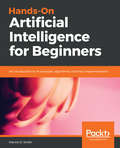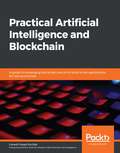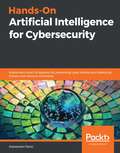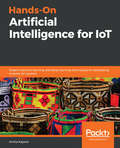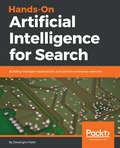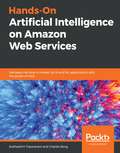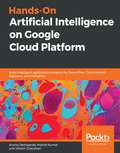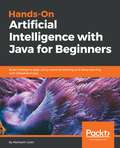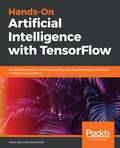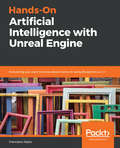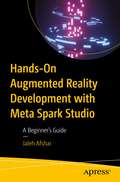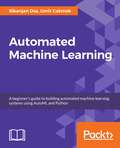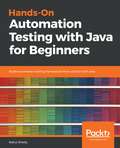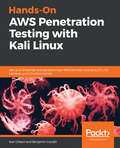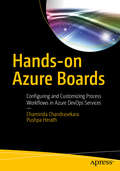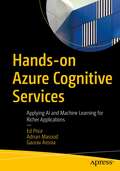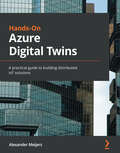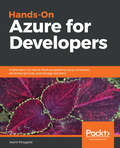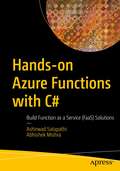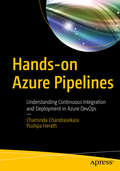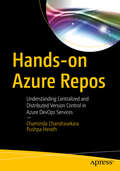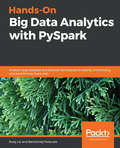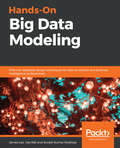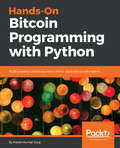- Table View
- List View
Hands-On Artificial Intelligence for Banking: A practical guide to building intelligent financial applications using machine learning techniques
by Subhash Shah Jeffrey Ng, CFADelve into the world of real-world financial applications using deep learning, artificial intelligence, and production-grade data feeds and technology with Python Key Features Understand how to obtain financial data via Quandl or internal systems Automate commercial banking using artificial intelligence and Python programs Implement various artificial intelligence models to make personal banking easy Book Description Remodeling your outlook on banking begins with keeping up to date with the latest and most effective approaches, such as artificial intelligence (AI). Hands-On Artificial Intelligence for Banking is a practical guide that will help you advance in your career in the banking domain. The book will demonstrate AI implementation to make your banking services smoother, more cost-efficient, and accessible to clients, focusing on both the client- and server-side uses of AI. You'll begin by understanding the importance of artificial intelligence, while also gaining insights into the recent AI revolution in the banking industry. Next, you'll get hands-on machine learning experience, exploring how to use time series analysis and reinforcement learning to automate client procurements and banking and finance decisions. After this, you'll progress to learning about mechanizing capital market decisions, using automated portfolio management systems and predicting the future of investment banking. In addition to this, you'll explore concepts such as building personal wealth advisors and mass customization of client lifetime wealth. Finally, you'll get to grips with some real-world AI considerations in the field of banking. By the end of this book, you'll be equipped with the skills you need to navigate the finance domain by leveraging the power of AI. What you will learn Automate commercial bank pricing with reinforcement learning Perform technical analysis using convolutional layers in Keras Use natural language processing (NLP) for predicting market responses and visualizing them using graph databases Deploy a robot advisor to manage your personal finances via Open Bank API Sense market needs using sentiment analysis for algorithmic marketing Explore AI adoption in banking using practical examples Understand how to obtain financial data from commercial, open, and internal sources Who this book is for This is one of the most useful artificial intelligence books for machine learning engineers, data engineers, and data scientists working in the finance industry who are looking to implement AI in their business applications. The book will also help entrepreneurs, venture capitalists, investment bankers, and wealth managers who want to understand the importance of AI in finance and banking and how it can help them solve different problems related to these domains. Prior experience in the financial markets or banking domain, and working knowledge of the Python programming language are a must.
Hands-On Artificial Intelligence for Beginners: An introduction to AI concepts, algorithms, and their implementation
by Patrick D. SmithGrasp the fundamentals of Artificial Intelligence and build your own intelligent systems with easeKey FeaturesEnter the world of AI with the help of solid concepts and real-world use casesExplore AI components to build real-world automated intelligenceBecome well versed with machine learning and deep learning conceptsBook DescriptionVirtual Assistants, such as Alexa and Siri, process our requests, Google's cars have started to read addresses, and Amazon's prices and Netflix's recommended videos are decided by AI. Artificial Intelligence is one of the most exciting technologies and is becoming increasingly significant in the modern world.Hands-On Artificial Intelligence for Beginners will teach you what Artificial Intelligence is and how to design and build intelligent applications. This book will teach you to harness packages such as TensorFlow in order to create powerful AI systems. You will begin with reviewing the recent changes in AI and learning how artificial neural networks (ANNs) have enabled more intelligent AI. You'll explore feedforward, recurrent, convolutional, and generative neural networks (FFNNs, RNNs, CNNs, and GNNs), as well as reinforcement learning methods. In the concluding chapters, you'll learn how to implement these methods for a variety of tasks, such as generating text for chatbots, and playing board and video games.By the end of this book, you will be able to understand exactly what you need to consider when optimizing ANNs and how to deploy and maintain AI applications.What you will learnUse TensorFlow packages to create AI systemsBuild feedforward, convolutional, and recurrent neural networksImplement generative models for text generationBuild reinforcement learning algorithms to play gamesAssemble RNNs, CNNs, and decoders to create an intelligent assistantUtilize RNNs to predict stock market behaviorCreate and scale training pipelines and deployment architectures for AI systemsWho this book is forThis book is designed for beginners in AI, aspiring AI developers, as well as machine learning enthusiasts with an interest in leveraging various algorithms to build powerful AI applications.
Hands-On Artificial Intelligence for Blockchain: A guide to converging blockchain and AI to build smart applications for new economies
by Ganesh Prasad KumbleThis book is for blockchain and AI architects, developers, data scientists, data engineers and evangelists who want to bring the power of artificial intelligence in Blockchain applications. If you want a perfect blend of theoretical and practical use cases to understand how to implement smart cognitive insights into blockchain solutions, this book is what you need! Having some knowledge of machine learning and blockchain concepts are mandatory.
Hands-On Artificial Intelligence for Cybersecurity: Implement smart AI systems for preventing cyber attacks and detecting threats and network anomalies
by Alessandro ParisiBuild smart cybersecurity systems with the power of machine learning and deep learning to protect your corporate assets Key Features Identify and predict security threats using artificial intelligence Develop intelligent systems that can detect unusual and suspicious patterns and attacks Learn how to test the effectiveness of your AI cybersecurity algorithms and tools Book Description Today's organizations spend billions of dollars globally on cybersecurity. Artificial intelligence has emerged as a great solution for building smarter and safer security systems that allow you to predict and detect suspicious network activity, such as phishing or unauthorized intrusions. This cybersecurity book presents and demonstrates popular and successful AI approaches and models that you can adapt to detect potential attacks and protect your corporate systems. You'll learn about the role of machine learning and neural networks, as well as deep learning in cybersecurity, and you'll also learn how you can infuse AI capabilities into building smart defensive mechanisms. As you advance, you'll be able to apply these strategies across a variety of applications, including spam filters, network intrusion detection, botnet detection, and secure authentication. By the end of this book, you'll be ready to develop intelligent systems that can detect unusual and suspicious patterns and attacks, thereby developing strong network security defenses using AI. What you will learn Detect email threats such as spamming and phishing using AI Categorize APT, zero-days, and polymorphic malware samples Overcome antivirus limits in threat detection Predict network intrusions and detect anomalies with machine learning Verify the strength of biometric authentication procedures with deep learning Evaluate cybersecurity strategies and learn how you can improve them Who this book is for If you're a cybersecurity professional or ethical hacker who wants to build intelligent systems using the power of machine learning and AI, you'll find this book useful. Familiarity with cybersecurity concepts and knowledge of Python programming is essential to get the most out of this book.
Hands-On Artificial Intelligence for IoT: Expert machine learning and deep learning techniques for developing smarter IoT systems
by Amita KapoorBuild smarter systems by combining artificial intelligence and the Internet of Things—two of the most talked about topics today Key Features Leverage the power of Python libraries such as TensorFlow and Keras to work with real-time IoT data Process IoT data and predict outcomes in real time to build smart IoT models Cover practical case studies on industrial IoT, smart cities, and home automation Book Description There are many applications that use data science and analytics to gain insights from terabytes of data. These apps, however, do not address the challenge of continually discovering patterns for IoT data. In Hands-On Artificial Intelligence for IoT, we cover various aspects of artificial intelligence (AI) and its implementation to make your IoT solutions smarter. This book starts by covering the process of gathering and preprocessing IoT data gathered from distributed sources. You will learn different AI techniques such as machine learning, deep learning, reinforcement learning, and natural language processing to build smart IoT systems. You will also leverage the power of AI to handle real-time data coming from wearable devices. As you progress through the book, techniques for building models that work with different kinds of data generated and consumed by IoT devices such as time series, images, and audio will be covered. Useful case studies on four major application areas of IoT solutions are a key focal point of this book. In the concluding chapters, you will leverage the power of widely used Python libraries, TensorFlow and Keras, to build different kinds of smart AI models. By the end of this book, you will be able to build smart AI-powered IoT apps with confidence. What you will learn Apply different AI techniques including machine learning and deep learning using TensorFlow and Keras Access and process data from various distributed sources Perform supervised and unsupervised machine learning for IoT data Implement distributed processing of IoT data over Apache Spark using the MLLib and H2O.ai platforms Forecast time-series data using deep learning methods Implementing AI from case studies in Personal IoT, Industrial IoT, and Smart Cities Gain unique insights from data obtained from wearable devices and smart devices Who this book is for If you are a data science professional or a machine learning developer looking to build smart systems for IoT, Hands-On Artificial Intelligence for IoT is for you. If you want to learn how popular artificial intelligence (AI) techniques can be used in the Internet of Things domain, this book will also be of benefit. A basic understanding of machine learning concepts will be required to get the best out of this book.
Hands-On Artificial Intelligence for Search: Building intelligent applications and perform enterprise searches
by Devangini PatelMake your searches more responsive and smarter by applying Artificial Intelligence to itKey FeaturesEnter the world of Artificial Intelligence with solid concepts and real-world use casesMake your applications intelligent using AI in your day-to-day apps and become a smart developerDesign and implement artificial intelligence in searchesBook DescriptionWith the emergence of big data and modern technologies, AI has acquired a lot of relevance in many domains. The increase in demand for automation has generated many applications for AI in fields such as robotics, predictive analytics, finance, and more.In this book, you will understand what artificial intelligence is. It explains in detail basic search methods: Depth-First Search (DFS), Breadth-First Search (BFS), and A* Search, which can be used to make intelligent decisions when the initial state, end state, and possible actions are known. Random solutions or greedy solutions can be found for such problems. But these are not optimal in either space or time and efficient approaches in time and space will be explored. We will also understand how to formulate a problem, which involves looking at it and identifying its initial state, goal state, and the actions that are possible in each state. We also need to understand the data structures involved while implementing these search algorithms as they form the basis of search exploration. Finally, we will look into what a heuristic is as this decides the quality of one sub-solution over another and helps you decide which step to take.What you will learnUnderstand the instances where searches can be usedUnderstand the algorithms that can be used to make decisions more intelligentFormulate a problem by specifying its initial state, goal state, and actionsTranslate the concepts of the selected search algorithm into codeCompare how basic search algorithms will perform for the applicationImplement algorithmic programming using code examplesWho this book is forThis book is for developers who are keen to get started with Artificial Intelligence and develop practical AI-based applications. Those developers who want to upgrade their normal applications to smart and intelligent versions will find this book useful. A basic knowledge and understanding of Python are assumed.
Hands-On Artificial Intelligence on Amazon Web Services: Decrease the time to market for AI and ML applications with the power of AWS
by Subhashini Tripuraneni Charles SongPerform cloud-based machine learning and deep learning using Amazon Web Services such as SageMaker, Lex, Comprehend, Translate, and Polly Key Features Explore popular machine learning and deep learning services with their underlying algorithms Discover readily available artificial intelligence(AI) APIs on AWS like Vision and Language Services Design robust architectures to enable experimentation, extensibility, and maintainability of AI apps Book Description From data wrangling through to translating text, you can accomplish this and more with the artificial intelligence and machine learning services available on AWS. With this book, you'll work through hands-on exercises and learn to use these services to solve real-world problems. You'll even design, develop, monitor, and maintain machine and deep learning models on AWS. The book starts with an introduction to AI and its applications in different industries, along with an overview of AWS artificial intelligence and machine learning services. You'll then get to grips with detecting and translating text with Amazon Rekognition and Amazon Translate. The book will assist you in performing speech-to-text with Amazon Transcribe and Amazon Polly. Later, you'll discover the use of Amazon Comprehend for extracting information from text, and Amazon Lex for building voice chatbots. You will also understand the key capabilities of Amazon SageMaker such as wrangling big data, discovering topics in text collections, and classifying images. Finally, you'll cover sales forecasting with deep learning and autoregression, before exploring the importance of a feedback loop in machine learning. By the end of this book, you will have the skills you need to implement AI in AWS through hands-on exercises that cover all aspects of the ML model life cycle. What you will learn Gain useful insights into different machine and deep learning models Build and deploy robust deep learning systems to production Train machine and deep learning models with diverse infrastructure specifications Scale AI apps without dealing with the complexity of managing the underlying infrastructure Monitor and Manage AI experiments efficiently Create AI apps using AWS pre-trained AI services Who this book is for This book is for data scientists, machine learning developers, deep learning researchers, and artificial intelligence enthusiasts who want to harness the power of AWS to implement powerful artificial intelligence solutions. A basic understanding of machine learning concepts is expected.
Hands-On Artificial Intelligence on Google Cloud Platform: Build intelligent applications powered by TensorFlow, Cloud AutoML, BigQuery, and Dialogflow
by Anand Deshpande Manish Kumar Vikram ChaudhariDevelop robust AI applications with TensorFlow, Cloud AutoML, TPUs, and other GCP services Key Features Focus on AI model development and deployment in GCP without worrying about infrastructure Manage feature processing, data storage, and trained models using Google Cloud Dataflow Access key frameworks such as TensorFlow and Cloud AutoML to run your deep learning models Book Description With a wide range of exciting tools and libraries such as Google BigQuery, Google Cloud Dataflow, and Google Cloud Dataproc, Google Cloud Platform (GCP) enables efficient big data processing and the development of smart AI models on the cloud. This GCP book will guide you in using these tools to build your AI-powered applications with ease and managing thousands of AI implementations on the cloud to help save you time. Starting with a brief overview of Cloud AI and GCP features, you'll learn how to deal with large volumes of data using auto-scaling features. You'll then implement Cloud AutoML to demonstrate the use of streaming components for performing data analytics and understand how Dialogflow can be used to create a conversational interface. As you advance, you'll be able to scale out and speed up AI and predictive applications using TensorFlow. You'll also leverage GCP to train and optimize deep learning models, run machine learning algorithms, and perform complex GPU computations using TPUs. Finally, you'll build and deploy AI applications to production with the help of an end-to-end use case. By the end of this book, you'll have learned how to design and run experiments and be able to discover innovative solutions without worrying about infrastructure, resources, and computing power. What you will learn Understand the basics of cloud computing and explore GCP components Work with the data ingestion and preprocessing techniques in GCP for machine learning Implement machine learning algorithms with Google Cloud AutoML Optimize TensorFlow machine learning with Google Cloud TPUs Get to grips with operationalizing AI on GCP Build an end-to-end machine learning pipeline using Cloud Storage, Cloud Dataflow, and Cloud Datalab Build models from petabytes of structured and semi-structured data using BigQuery ML Who this book is for If you're an artificial intelligence developer, data scientist, machine learning engineer, or deep learning engineer looking to build and deploy smart applications on Google Cloud Platform, you'll find this book useful. A fundamental understanding of basic data processing and machine learning concepts is necessary. Though not mandatory, familiarity with Google Cloud Platform will help you make the most of this book.
Hands-On Artificial Intelligence with Java for Beginners: Build intelligent apps using machine learning and deep learning with Deeplearning4j
by Nisheeth JoshiBuild, train, and deploy intelligent applications using Java librariesKey FeaturesLeverage the power of Java libraries to build smart applicationsBuild and train deep learning models for implementing artificial intelligenceLearn various algorithms to automate complex tasksBook DescriptionArtificial intelligence (AI) is increasingly in demand as well as relevant in the modern world, where everything is driven by technology and data. AI can be used for automating systems or processes to carry out complex tasks and functions in order to achieve optimal performance and productivity.Hands-On Artificial Intelligence with Java for Beginners begins by introducing you to AI concepts and algorithms. You will learn about various Java-based libraries and frameworks that can be used in implementing AI to build smart applications. In addition to this, the book teaches you how to implement easy to complex AI tasks, such as genetic programming, heuristic searches, reinforcement learning, neural networks, and segmentation, all with a practical approach.By the end of this book, you will not only have a solid grasp of AI concepts, but you'll also be able to build your own smart applications for multiple domains.What you will learnLeverage different Java packages and tools such as Weka, RapidMiner, and Deeplearning4j, among othersBuild machine learning models using supervised and unsupervised machine learning techniquesImplement different deep learning algorithms in Deeplearning4j and build applications based on themStudy the basics of heuristic searching and genetic programmingDifferentiate between syntactic and semantic similarity among textsPerform sentiment analysis for effective decision making with LingPipeWho this book is forHands-On Artificial Intelligence with Java for Beginners is for Java developers who want to learn the fundamentals of artificial intelligence and extend their programming knowledge to build smarter applications.
Hands-On Artificial Intelligence with TensorFlow: Useful techniques in machine learning and deep learning for building intelligent applications
by Amir Ziai Ankit DixitExploit TensorFlow's capabilities to build artificial intelligence applicationsKey FeaturesExploit TensorFlow's new features to power your artificial intelligence appsImplement machine learning, deep learning, and reinforcement learning models with TensorflowBuild intelligent applications for computer vision, NLP, and healthcare, among othersBook DescriptionArtificial Intelligence (AI) is a popular area with an emphasis on creating intelligent machines that can reason, evaluate, and understand the same way as humans. It is used extensively across many fields, such as image recognition, robotics, language processing, healthcare, finance, and more.Hands-On Artificial Intelligence with TensorFlow gives you a rundown of essential AI concepts and their implementation with TensorFlow, also highlighting different approaches to solving AI problems using machine learning and deep learning techniques. In addition to this, the book covers advanced concepts, such as reinforcement learning, generative adversarial networks (GANs), and multimodal learning.Once you have grasped all this, you’ll move on to exploring GPU computing and neuromorphic computing, along with the latest trends in quantum computing. You’ll work through case studies that will help you examine AI applications in the important areas of computer vision, healthcare, and FinTech, and analyze their datasets. In the concluding chapters, you’ll briefly investigate possible developments in AI that we can expect to see in the future.By the end of this book, you will be well-versed with the essential concepts of AI and their implementation using TensorFlow.What you will learnExplore the core concepts of AI and its different approachesUse the TensorFlow framework for smart applicationsImplement various machine and deep learning algorithms with TensorFlowDesign self-learning RL systems and implement generative modelsPerform GPU computing efficiently using best practicesBuild enterprise-grade apps for computer vision, NLP, and healthcareWho this book is forHands-On Artificial Intelligence with TensorFlow is for you if you are a machine learning developer, data scientist, AI researcher, or anyone who wants to build artificial intelligence applications using TensorFlow. You need to have some working knowledge of machine learning to get the most out of this book.
Hands-On Artificial Intelligence with Unreal Engine: Everything you want to know about Game AI using Blueprints or C++
by Francesco SapioLearn to build intelligent and responsive Non-Player Characters for your games with Unreal Engine Game AI.Key FeaturesUnderstand the built-in AI systems in Unreal Engine for building intelligent gamesLeverage the power of Unreal Engine 4 programming to create game AI that focuses on motion, animation, and tacticsLearn to profile, visualize, and debug your Game AI for checking logic and optimizing performanceBook DescriptionLearning how to apply artificial intelligence ( AI ) is crucial and can take the fun factor to the next level, whether you're developing a traditional, educational, or any other kind of game. If you want to use AI to extend the life of your games and make them challenging and more interesting, this book is for you.The book starts by breaking down AI into simple concepts to get a fundamental understanding of it. Using a variety of examples, you will work through actual implementations designed to highlight key concepts and features related to game AI in UE4. You will learn to work through the built-in AI framework in order to build believable characters for every game genre (including RPG, Strategic, Platform, FPS, Simulation, Arcade, and Educational). You will learn to configure the Navigation, Environmental Querying, and Perception systems for your AI agents and couple these with Behavior Trees, all accompanied with practical examples. You will also explore how the engine handles dynamic crowds. In the concluding chapters, you will learn how to profile, visualize, and debug your AI systems to correct the AI logic and increase performance.By the end of the book, your AI knowledge of the built-in AI system in Unreal will be deep and comprehensive, allowing you to build powerful AI agents within your projects.What you will learnGet an in-depth knowledge about all the AI Systems within Unreal EngineCreate complex AIs, understanding the art of designing and developing Behavior TreeLearn how to perform Environmental Queries (EQS)Master the Navigation, Perception, and Crowd SystemsProfile and Visualize the AI Systems with powerful debugging toolsExtend every AI and Debug system with custom nodes and functionsWho this book is forHands-On Artificial Intelligence with Unreal Engine is for you if you are a game developer with a bit experience in Unreal Engine, and now want to understand and implement believable game AI within Unreal Engine. The book will be both in Blueprint and C++, allowing people from every background to enjoy the book. Whether you're looking to build your first game or expand your knowledge to the edge as a Game AI Programmer, you will find plenty of exciting information and examples of game AI in terms of concepts and implementation, including how to extend some of these systems.
Hands-On Augmented Reality Development with Meta Spark Studio: A Beginner’s Guide
by Jaleh AfsharBuild augmented reality effects using Spark AR focusing on practical, project-based learning. With access to this technology being available in nearly every smartphone, the world of AR is expanding every day. Now is a great time to tell your creative story through this new medium. We will begin by learning the fundamentals of augmented reality, become familiar with key terminology, and discover the use cases this technology is most effective for. Using that foundational knowledge, we will learn how to make selfie effects, create virtual objects in the real world, and build games that respond to facial expressions and physical inputs.On completing the book, you will learn to ship effects publicly, to market their effects, and to create effects which are inclusive to their audience and have real user value.You Will • Create a face-tracking and object-tracking project in Spark AR• Understand how to customize assets and parameters • Create demo videos and icons to represent their AR effects• Learn to package the effects for publishing officially to social media channelsWho Is This Book ForThis book is ideal for students, educators, creatives, small-business owners, or anyone else interested in creating immersive AR experiences for social networking platforms such as Instagram and Facebook. No coding or design experience is required.
Hands-On Automated Machine Learning: A beginner's guide to building automated machine learning systems using AutoML and Python
by Sibanjan Das Umit Mert CakmakAutomate data and model pipelines for faster machine learning applicationsKey FeaturesBuild automated modules for different machine learning componentsUnderstand each component of a machine learning pipeline in depthLearn to use different open source AutoML and feature engineering platformsBook DescriptionAutoML is designed to automate parts of Machine Learning. Readily available AutoML tools are making data science practitioners’ work easy and are received well in the advanced analytics community. Automated Machine Learning covers the necessary foundation needed to create automated machine learning modules and helps you get up to speed with them in the most practical way possible. In this book, you’ll learn how to automate different tasks in the machine learning pipeline such as data preprocessing, feature selection, model training, model optimization, and much more. In addition to this, it demonstrates how you can use the available automation libraries, such as auto-sklearn and MLBox, and create and extend your own custom AutoML components for Machine Learning. By the end of this book, you will have a clearer understanding of the different aspects of automated Machine Learning, and you’ll be able to incorporate automation tasks using practical datasets. You can leverage your learning from this book to implement Machine Learning in your projects and get a step closer to winning various machine learning competitions.What you will learnUnderstand the fundamentals of Automated Machine Learning systemsExplore auto-sklearn and MLBox for AutoML tasks Automate your preprocessing methods along with feature transformationEnhance feature selection and generation using the Python stackAssemble individual components of ML into a complete AutoML frameworkDemystify hyperparameter tuning to optimize your ML modelsDive into Machine Learning concepts such as neural networks and autoencoders Understand the information costs and trade-offs associated with AutoMLWho this book is forIf you’re a budding data scientist, data analyst, or Machine Learning enthusiast and are new to the concept of automated machine learning, this book is ideal for you. You’ll also find this book useful if you’re an ML engineer or data professional interested in developing quick machine learning pipelines for your projects. Prior exposure to Python programming will help you get the best out of this book.
Hands-On Automation Testing with Java for Beginners: Build automation testing frameworks from scratch with Java
by Rahul ShettyLearn Java programming concepts to design automation testing frameworksKey FeaturesLearn to use Java program logic in application testingUnderstand various test-driven development concepts with Java toolsMaster Java with lots of programming examplesBook DescriptionJava is one of the most commonly-used software languages by programmers and developers. Are you from a non-technical background and looking to master Java for your automation needs? Then Hands-On Automation Testing with Java for Beginners is for you.This book provides you with efficient techniques to effectively handle Java-related automation projects. You will learn how to handle strings and their functions in Java. As you make your way through the book, you will get to grips with classes and objects, along with their uses. In the concluding chapters, you will learn about the importance of inheritance and exceptions with practical examples. By the end of this book, you will have gained comprehensive knowledge of Java.What you will learnUnderstand the practical usage of Java conditions and loopsWrite any Java program logic with strategies, tips, and tricksLeverage advanced topics in Java collections to solve Java-related problemsUnderstand and use objects, classes, methods, and functions in JavaBuild Java automation frameworks from scratchObtain knowledge of Java object-oriented programming (OOP) concepts with practical implementationsWho this book is forHands-On Automation Testing with Java for Beginners is for software developers who want to step into the world of software quality assurance and perform automation testing using various testing frameworks. Prior experience of writing tests in Java is assumed.
Hands-On AWS Penetration Testing with Kali Linux: Set up a virtual lab and pentest major AWS services, including EC2, S3, Lambda, and CloudFormation
by Karl Gilbert Benjamin CaudillIdentify tools and techniques to secure and perform a penetration test on an AWS infrastructure using Kali LinuxKey FeaturesEfficiently perform penetration testing techniques on your public cloud instancesLearn not only to cover loopholes but also to automate security monitoring and alerting within your cloud-based deployment pipelinesA step-by-step guide that will help you leverage the most widely used security platform to secure your AWS Cloud environmentBook DescriptionThe cloud is taking over the IT industry. Any organization housing a large amount of data or a large infrastructure has started moving cloud-ward — and AWS rules the roost when it comes to cloud service providers, with its closest competitor having less than half of its market share. This highlights the importance of security on the cloud, especially on AWS. While a lot has been said (and written) about how cloud environments can be secured, performing external security assessments in the form of pentests on AWS is still seen as a dark art. This book aims to help pentesters as well as seasoned system administrators with a hands-on approach to pentesting the various cloud services provided by Amazon through AWS using Kali Linux. To make things easier for novice pentesters, the book focuses on building a practice lab and refining penetration testing with Kali Linux on the cloud. This is helpful not only for beginners but also for pentesters who want to set up a pentesting environment in their private cloud, using Kali Linux to perform a white-box assessment of their own cloud resources. Besides this, there is a lot of in-depth coverage of the large variety of AWS services that are often overlooked during a pentest — from serverless infrastructure to automated deployment pipelines.By the end of this book, you will be able to identify possible vulnerable areas efficiently and secure your AWS cloud environment.What you will learnFamiliarize yourself with and pentest the most common external-facing AWS servicesAudit your own infrastructure and identify flaws, weaknesses, and loopholesDemonstrate the process of lateral and vertical movement through a partially compromised AWS accountMaintain stealth and persistence within a compromised AWS accountMaster a hands-on approach to pentestingDiscover a number of automated tools to ease the process of continuously assessing and improving the security stance of an AWS infrastructureWho this book is forIf you are a security analyst or a penetration tester and are interested in exploiting Cloud environments to reveal vulnerable areas and secure them, then this book is for you. A basic understanding of penetration testing, cloud computing, and its security concepts is mandatory.
Hands-on Azure Boards: Configuring and Customizing Process Workflows in Azure DevOps Services
by Chaminda Chandrasekara Pushpa HerathUnderstand and explore the features and management of Azure Boards with this book, which also covers Azure Boards configuration and advanced administration. This book starts by setting up projects with Azure DevOps and gives an overview of Azure Boards and its features. You will then learn to set up team projects and how to effectively use Azure Boards to plan and execute work. Hands-on Azure Boards explains customizations, where you will understand the available options to track your work considering different scenarios. Next, you will learn visualizing with queries, charts, and dashboards along with reporting of Azure Boards. The author gives you hands-on lessons to set up Azure Boards and shows you how to handle multiple modules that are taken care of by different teams. You will also explore the security options in Azure Boards as well as a detailed demonstration of working with the REST API and CLI. Finally, you will work with useful extensions for Azure Boards and see how to use them more effectively and efficiently. After reading this book, you will be able to work with the Azure Boards capabilities available in Azure DevOps on-premise server and services to improve your software delivery process. What You Will LearnPlan and manage work with Azure BoardsUse the REST API and command line interface with Azure BoardsExtend Azure Boards with useful extensions to enhance its capabilities Customize Azure Boards to adapt it to your processReport and visualize work progress with Azure BoardsWho This Book Is ForAnyone working in Azure DevOps developing applications targeting any platform using any language.
Hands-on Azure Cognitive Services: Applying AI and Machine Learning for Richer Applications
by Ed Price Adnan Masood Gaurav AroraaUse this hands-on guide book to learn and explore cognitive APIs developed by Microsoft and provided with the Azure platform. This book gets you started working with Azure Cognitive Services. You will not only become familiar with Cognitive Services APIs for applications, but you will also be exposed to methods to make your applications intelligent for deployment in businesses.The book starts with the basic concepts of Azure Cognitive Services and takes you through its features and capabilities. You then learn how to work inside the Azure Marketplace for Bot Services, Cognitive Services, and Machine Learning. You will be shown how to build an application to analyze images and videos, and you will gain insight on natural language processing (NLP). Speech Services and Decision Services are discussed along with a preview of Anomaly Detector. You will go through Bing Search APIs and learn how to deploy and host services by using containers. And you will learn how to use Azure Machine Learning and create bots for COVID-19 safety, using Azure Bot Service.After reading this book, you will be able to work with datasets that enable applications to process various data in the form of images, videos, and text.What You Will Learn Discover the options for training and operationalizing deep learning models on AzureBe familiar with advanced concepts in Azure ML and the Cortana Intelligence Suite architectureUnderstand software development kits (SKDs)Deploy an application to Azure Kubernetes Service Who This Book Is ForDevelopers working on a range of platforms, from .NET and Windows to mobile devices, as well as data scientists who want to explore and learn more about deep learning and implement it using the Microsoft AI platform
Hands-On Azure Digital Twins: A practical guide to building distributed IoT solutions
by Alexander MeijersBuild your own digital twin in no time!Key FeaturesBuild and design simple to complex digital twins solutionsCreate end-to-end solutions with Azure Digital TwinsIntegrate the Azure Digital Twins service with other Azure services to provide even richer solutionsBook DescriptionIn today's world, clients are using more and more IoT sensors to monitor their business processes and assets. Think about collecting information such as pressure in an engine, the temperature, or a light switch being turned on or off in a room. The data collected can be used to create smart solutions for predicting future trends, creating simulations, and drawing insights using visualizations. This makes it beneficial for organizations to make digital twins, which are digital replicas of the real environment, to support these smart solutions. This book will help you understand the concept of digital twins and how it can be implemented using an Azure service called Azure Digital Twins. Starting with the requirements and installation of the Azure Digital Twins service, the book will explain the definition language used for modeling digital twins. From there, you'll go through each step of building digital twins using Azure Digital Twins and learn about the different SDKs and APIs and how to use them with several Azure services. Finally, you'll learn how digital twins can be used in practice with the help of several real-world scenarios.By the end of this book, you'll be confident in building and designing digital twins and integrating them with various Azure services.What you will learnUnderstand the concept and architecture of Azure Digital TwinsGet to grips with installing and configuring the service and required toolsUnderstand the Digital Twin Definition Language (DTDL) and digital twin modelsExplore the APIs and SDKs available to access the Azure Digital Twins servicesMonitor, troubleshoot, and secure digital twinsDiscover how to build, design, and integrate applications with various Azure servicesExplore real-life scenarios with Azure Digital TwinsWho this book is forThis book is for Azure developers, Azure architects, and anyone who wants to learn more about how to implement IoT solutions using Azure Digital Twins and additional Azure services. Prior experience using the Azure Portal and a clear understanding of building applications using .NET will be helpful.
Hands-On Azure for Developers: Implement rich Azure PaaS ecosystems using containers, serverless services, and storage solutions
by Kamil MrzyglodThis book is targeted towards anyone who wants to learn about Azure services which will help them build highly scalable cloud-based applications with ease. Prior knowledge of Azure services will be an added advantage.
Hands-on Azure Functions with C#: Build Function as a Service (FaaS) Solutions
by Ashirwad Satapathi Abhishek MishraBuild serverless solutions using Azure Functions. This book provides you with a deep understanding of Azure Functions so you can build highly scalable and reliable serverless applications.The book starts with an introduction to Azure Functions and demonstrates triggers and bindings with use cases. The process to build an OTP mailer with Queue Storage Trigger and SendGrid output binding is presented, and timer triggers and blob storage binding are covered. Creating custom binding for Azure Functions and building a serverless API using Azure Functions and Azure SQL are discussed. You will know how to build a serverless API using Azure Functions and Azure Cosmos DB, and you will go over enabling application insights and Azure Monitor. Storing function secrets in Azure Key Vault is discussed as well as authentication and authorization using Azure Active Directory. You will learn how to secure your serverless apps using API Management and deploy your Azure Functions using IDEs.Deploying your Azure Functions using CI/CD pipelines is demonstrated along with running Azure Functions in containers. You will learn how to leverage Azure Cognitive Services to build intelligent serverless apps. And the authors introduce you to Azure Durable functions and teach you how to integrate Azure Functions in the logic app workflow. They also discuss best practices and pitfalls to avoid while designing Azure Functions.After reading this book, you will be able to design and deploy Azure Functions and implement solutions to real-world business problems through serverless applications. What Will You LearnMonitor and secure Azure FunctionsBuild and deploy Azure FunctionsEnable continuous integration/continuous deployment (CI/CD) DevOps strategies for Azure FunctionsRun Azure Functions on Azure Kubernetes Cluster Who This Book Is ForExperienced developers, cloud architects, and tech enthusiasts in Azure
Hands-on Azure Pipelines: Understanding Continuous Integration and Deployment in Azure DevOps
by Chaminda Chandrasekara Pushpa HerathBuild, package, and deploy software projects, developed with any language targeting any platform, using Azure pipelines.The book starts with an overview of CI/CD and the need for software delivery automation. It further delves into the basic concepts of Azure pipelines followed by a hands-on guide to setting up agents on all platforms enabling software development in any language. Moving forward, you will learn to set up a pipeline using the classic Visual Editor using PowerShell scripts, a REST API, building edit history, retention, and much more. You’ll work with artifact feeds to store deployment packages and consume them in a build. As part of the discussion you’ll see the implementation and usage of YAML (Yet Another Markup Language) build pipelines. You will then create Azure release pipelines in DevOps and develop extensions for Azure pipelines. Finally, you will learn various strategies and patterns for developing pipelines and go through some sample lessons on building and deploying pipelines. After reading Hands-on Azure Pipelines, you will be able to combine CI and CD to constantly and consistently test and build your code and ship it to any target.What You Will Learn Work with Azure build-and-release pipelines Extend the capabilities and features of Azure pipelines Understand build, package, and deployment strategies, and versioning and patterns with Azure pipelines Create infrastructure and deployment that targets commonly used Azure platform services Build and deploy mobile applications Use quick-start Azure DevOps projectsWho This Book Is ForSoftware developers and test automation engineers who are involved in the software delivery process.
Hands-on Azure Repos: Understanding Centralized and Distributed Version Control in Azure DevOps Services
by Chaminda Chandrasekara Pushpa HerathUse Azure Repos to manage your code in both centralized and distributed version control systems. This book will show you how to work with Team Foundation Version Control (TFVC) and distributed version control (Git), while exploring their best practices. You'll start with an introduction to Azure Repos, focusing on TFVC and Git, and then gradually transition to hands on lessons of working with TVFC. Next, you'll see how to set up and work with TFVC branches and tracking systems followed by usage of command line and security in TFVC Repos. Create and work on Git Repos in Azure DevOps and use branching with Azure Git Repos and Git command line in Visual Studio and vscode. The book then explores security in Git Repos and advanced options you can use to import from external Repos. With Hands-on Azure Repos as your guide, you'll be able to work with these version control tools on any platform and with any language.What You'll LearnIntegrate Azure Repos with Azure Boards to enable tracking work with code.Create guidelines to tackle difficult situations in using Azure ReposClone Azure Repo to local using Visual Studio and vscodeWork with shelvesets, code reviews and lock typesPerform activities using REST API with Azure ReposWho This Book Is ForSoftware developers, tech leads and architects.
Hands-On Big Data Analytics with PySpark: Analyze large datasets and discover techniques for testing, immunizing, and parallelizing Spark jobs
by Rudy Lai Bartlomiej PotaczekUse PySpark to easily crush messy data at-scale and discover proven techniques to create testable, immutable, and easily parallelizable Spark jobs Key Features Work with large amounts of agile data using distributed datasets and in-memory caching Source data from all popular data hosting platforms, such as HDFS, Hive, JSON, and S3 Employ the easy-to-use PySpark API to deploy big data Analytics for production Book Description Apache Spark is an open source parallel-processing framework that has been around for quite some time now. One of the many uses of Apache Spark is for data analytics applications across clustered computers. In this book, you will not only learn how to use Spark and the Python API to create high-performance analytics with big data, but also discover techniques for testing, immunizing, and parallelizing Spark jobs. You will learn how to source data from all popular data hosting platforms, including HDFS, Hive, JSON, and S3, and deal with large datasets with PySpark to gain practical big data experience. This book will help you work on prototypes on local machines and subsequently go on to handle messy data in production and at scale. This book covers installing and setting up PySpark, RDD operations, big data cleaning and wrangling, and aggregating and summarizing data into useful reports. You will also learn how to implement some practical and proven techniques to improve certain aspects of programming and administration in Apache Spark. By the end of the book, you will be able to build big data analytical solutions using the various PySpark offerings and also optimize them effectively. What you will learn Get practical big data experience while working on messy datasets Analyze patterns with Spark SQL to improve your business intelligence Use PySpark's interactive shell to speed up development time Create highly concurrent Spark programs by leveraging immutability Discover ways to avoid the most expensive operation in the Spark API: the shuffle operation Re-design your jobs to use reduceByKey instead of groupBy Create robust processing pipelines by testing Apache Spark jobs Who this book is for This book is for developers, data scientists, business analysts, or anyone who needs to reliably analyze large amounts of large-scale, real-world data. Whether you're tasked with creating your company's business intelligence function or creating great data platforms for your machine learning models, or are looking to use code to magnify the impact of your business, this book is for you.
Hands-On Big Data Modeling: Effective database design techniques for data architects and business intelligence professionals
by James Lee Tao WeiData Modelers, Data Architects, Database administrators, ETL developers, DW/BI professionals and Software Engineers will be the relevant users who want to design sophisticated and powerful database models.
Hands-On Bitcoin Programming with Python: Build powerful online payment centric applications with Python
by Harish Kumar GargSimplified Python programming for Bitcoin and blockchainKey FeaturesBuild Bitcoin applications in Python with the help of simple examplesMine Bitcoins, program Bitcoin-enabled APIs and transaction graphs, and build trading botsAnalyze Bitcoin transactions and produce visualizations using Python data analysis toolsBook DescriptionBitcoin is a cryptocurrency that’s changing the face of online payments. Hands-On Bitcoin Programming with Python teaches you to build software applications for mining and creating Bitcoins using Python.This book starts with the basics of both Bitcoin and blockchain and gives you an overview of these inherent concepts by showing you how to build Bitcoin-driven applications with Python. Packed with clear instructions and practical examples, you will learn to understand simple Python coding examples that work with this cryptocurrency.By the end of the book, you’ll be able to mine Bitcoins, accept Bitcoin payments on the app, and work with the basics of blockchain technology to create simply distributed ledgers.What you will learnMaster the Bitcoin APIs in Python to manipulate Bitcoin from your Python appsBuild your own Bitcoin trading bots to buy Bitcoins at a lower price and sell them at a higher priceWrite scripts to process Bitcoin payments through a website or appDevelop software for Bitcoin mining to create Bitcoin currency on your own computer hardwareCreate your own keys, addresses, and wallets in Python codeWrite software to analyze Bitcoin transactions and produce reports, graphs, and other visualizationsWho this book is forHands-On Bitcoin Programming with Python consists of examples that will teach you to build your own Bitcoin application. You will learn to write scripts, build software for mining, and create Bitcoins using Python. Anyone with prior Python experience, who wants to explore Python Bitcoin programming and start building Bitcoin-driven Python apps, will find this book useful.
